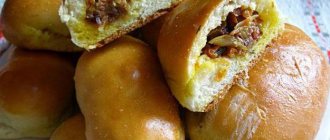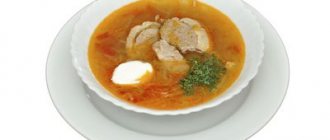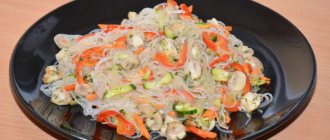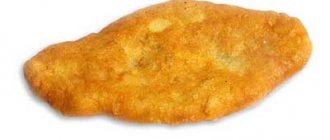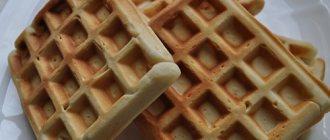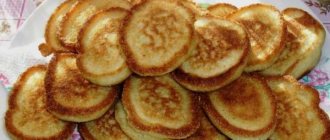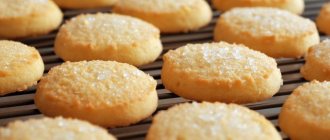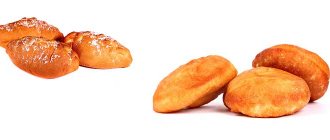What are the benefits of Potato and Meat Pie?
- Vitamin B1
is part of the most important enzymes of carbohydrate and energy metabolism, providing the body with energy and plastic substances, as well as the metabolism of branched amino acids. A lack of this vitamin leads to serious disorders of the nervous, digestive and cardiovascular systems. - Vitamin B2
is involved in redox reactions, helps to increase the color sensitivity of the visual analyzer and dark adaptation. Insufficient intake of vitamin B2 is accompanied by impaired condition of the skin, mucous membranes, and impaired light and twilight vision. - Vitamin B6
is involved in maintaining the immune response, processes of inhibition and excitation in the central nervous system, in the transformation of amino acids, the metabolism of tryptophan, lipids and nucleic acids, promotes the normal formation of red blood cells, and maintaining normal levels of homocysteine in the blood. Insufficient intake of vitamin B6 is accompanied by decreased appetite, impaired skin condition, and the development of homocysteinemia and anemia. - Vitamin B12
plays an important role in the metabolism and transformation of amino acids. Folate and vitamin B12 are interconnected vitamins that are involved in hematopoiesis. A lack of vitamin B12 leads to the development of partial or secondary folate deficiency, as well as anemia, leukopenia, and thrombocytopenia. - Vitamin E
has antioxidant properties, is necessary for the functioning of the gonads and heart muscle, and is a universal stabilizer of cell membranes. With vitamin E deficiency, hemolysis of erythrocytes and neurological disorders are observed. - Vitamin PP
is involved in redox reactions of energy metabolism. Insufficient vitamin intake is accompanied by disruption of the normal condition of the skin, gastrointestinal tract and nervous system. - Potassium
is the main intracellular ion that takes part in the regulation of water, acid and electrolyte balance, and is involved in the processes of conducting nerve impulses and regulating blood pressure. - Phosphorus
takes part in many physiological processes, including energy metabolism, regulates acid-base balance, is part of phospholipids, nucleotides and nucleic acids, and is necessary for the mineralization of bones and teeth. Deficiency leads to anorexia, anemia, and rickets. - Chlorine
is necessary for the formation and secretion of hydrochloric acid in the body. - Cobalt
is part of vitamin B12. Activates enzymes of fatty acid metabolism and folic acid metabolism. - Manganese
is involved in the formation of bone and connective tissue, and is part of enzymes involved in the metabolism of amino acids, carbohydrates, and catecholamines; necessary for the synthesis of cholesterol and nucleotides. Insufficient consumption is accompanied by slower growth, disturbances in the reproductive system, increased fragility of bone tissue, and disturbances in carbohydrate and lipid metabolism. - Copper
is part of enzymes that have redox activity and are involved in the metabolism of iron, stimulates the absorption of proteins and carbohydrates. Participates in the processes of providing oxygen to the tissues of the human body. Deficiency is manifested by disturbances in the formation of the cardiovascular system and skeleton, and the development of connective tissue dysplasia. - Molybdenum
is a cofactor for many enzymes that ensure the metabolism of sulfur-containing amino acids, purines and pyrimidines. - Chromium
is involved in the regulation of blood glucose levels, enhancing the effect of insulin. Deficiency leads to decreased glucose tolerance. - Zinc
is part of more than 300 enzymes and is involved in the processes of synthesis and breakdown of carbohydrates, proteins, fats, nucleic acids and in the regulation of the expression of a number of genes. Insufficient consumption leads to anemia, secondary immunodeficiency, liver cirrhosis, sexual dysfunction, and the presence of fetal malformations. Research in recent years has revealed the ability of high doses of zinc to disrupt the absorption of copper and thereby contribute to the development of anemia.
How many calories are in a pie
Baking is a weak point for many, and when on a diet, sometimes it’s easier to give up a cake or chocolate than a fragrant hot pie with meat or cheese. But baking on a diet is prohibited! And we, suffering, push away the plate with the pie and drink tea without sugar. Or we break down and eat the pie and the refills, while simultaneously counting how many calories are in the pies you just ate, and then we reproach ourselves and suffer from guilt.
In fact, it's not worth doing either one or the other. Even if you are on a diet to lose weight, you can periodically allow yourself to deviate a little from this diet and indulge in something very desirable. There is even a special technique for systematically planned mini-breakdowns from the diet - cheat meals. Its essence is that you determine for yourself one day a week on which you can, in addition to your dietary intake, allow yourself something else (anything, even harmful) within 1/4 of your dietary caloric intake. That is, if you limited your daily diet to 1300 calories, then once a week you can eat an additional 325 calories. It's a small thing, but nice. You will become much easier to endure the diet, knowing that on Wednesday or Saturday you will have a delicious gift from yourself, which means that the danger of failure will be much less. And another benefit from a cheat meal is that by giving your body such surprises in the form of a cake or pie once a week, you prevent it from resetting your metabolism to an economical mode, slowing down your metabolism and starting to save energy, which often happens during diets . The only danger with a cheat meal is that you may become lazy and exceed the permissible diet deviation limit or start having a “belly feast” too often. Therefore, even when deviating from your diet, watch your calories.
Since we are currently talking about pies with filling, we are concerned with the question of how many calories are in the pies.
Pie with potatoes: calorie content and composition
It is simply impossible to imagine Russian cuisine without pies with various fillings.
The pie is a small pie filled with meat, fish, berries, jam and preserves, vegetables and fruits. There are a huge number of options. The pie is an excellent snack. You can grab it while running, throw it in your mouth and not feel hungry for quite a long time. The savory pie can be served for lunch or dinner.
This is a great alternative to bread.
But one of the most popular and favorite is potato pie. The calorie content of this dish, like other “cookies,” certainly frightens those who follow proper nutrition or are on a strict diet. But, as nutritionists say, there is a difference between pie and pie. Here everything will depend on the method of its preparation.
So let's figure out which type of baked goods is healthier and tastier. Which potato pie to choose for yourself, the calorie content of which would not frighten you and would not give you negative emotions the next morning when you look at the scales.
Pie - a delicacy for children and vegetarians
There are thousands of recipes for making pies in the world. Sweet pies are undoubtedly a favorite treat for children. As children, the question is not so important to us: “Can I eat a pie with potatoes for dinner? Calorie content 1 pc. – how much is it? Will this harm your figure? This doesn’t matter to children, and kids need calories, because they spend a lot of them, unlike some adults.
Pies with vegetable fillings are perfect for those who are on a diet or are vegetarians. If you prepare the dough correctly and add not a fatty meat filling, but, say, stewed cabbage or boiled potatoes, then the pies will be a very diet-friendly dish.
Composition and method of preparing pies
As we have already said, depending on the type of dough and the composition of the filling, the calorie content of the dish will also change. If you follow proper nutrition, be sure to take this fact into account. People who are obese should avoid pies with fatty meat fillings and yeast dough. In addition, you should not eat baked goods fried in oil.
The average calorie content is 250 kcal per hundred grams of baked goods. If it is a pie with fruit filling, the calorie content is 240 kcal per hundred grams. If it is a pie with potatoes, the calorie content is 235 kcal. For pies with meat filling, the calorie content will be increased by at least ten kilocalories per hundred grams - 260-276.
The difference will be quite significant depending on the type of preparation. Let's take, for example, baked goods cooked in the oven. Pies with potatoes in the oven - calorie content 230-235 kcal, pies with apple filling in the oven - 175 kcal, with cottage cheese - 206 kcal, with fish filling - calorie content 176-180 kcal.
Now let’s compare the same baked goods, only prepared by immersion in liters of boiling oil. Fried pies with cabbage – 263 kcal. Potato pies prepared by frying - calorie content per 100 grams: 276.
Even the calorie content of pies with berry or fruit fillings increases significantly. If a baked apple pie is 175 kcal per hundred grams of dish, then the fried version will be an order of magnitude larger - 207 kcal.
Feel the difference.
Pie dough
The calorie content of the pies is also affected by the dough in which the filling is wrapped. The most nutritious is, of course, rich yeast and puff pastry. One contains a lot of flour and yeast, sugar, the other contains flour and butter, without which it is simply impossible to prepare delicious puff pastry. Also, pies can be made from unleavened, shortbread, or choux pastry.
Avoid fried pies
No matter how delicious the pies fried in oil may seem to you, any nutritionist will recommend that you give them up. Tasty? Yes. Healthy? Of course not!
In addition to the fact that eating fried pies will negatively affect your figure, it will also affect your health. Not only is the calorie content of a baked potato pie lower, but the health benefits of eating such baked goods are also greater.
Fried pastries should not be consumed for several reasons:
- As a result of frying, free radicals are formed that harm our body, leading to heart problems, causing atherosclerosis of blood vessels.
- Fatty foods will always have a negative effect on the gastrointestinal tract. Constant heartburn, constipation and heaviness in the abdomen, a feeling of bloating and pain in the stomach.
- Even cancer can develop only because you often eat pies fried in oil. It is especially scary when the oil is used repeatedly, as is done in most roadside cafes or poor quality catering centers.
Replace fried pastries with baked ones. What will happen?
- As a result of the heat affecting the yeast, energy is released, which the pies will later “share” with you. Yeast bacillus can normalize digestion. It also helps normalize intestinal function and improves the state of microflora in the stomach and intestines.
- For example, a baked pie with potatoes, which is low in calories, will never have a negative impact on your figure. The nutrients contained in potatoes or any other vegetable fillings will only benefit you. When frying pies in the oven, no beneficial substances are lost. The body feels only benefits, immunity improves and resistance to various colds increases.
- Baked pie is an excellent snack or even a full lunch for schoolchildren, active children and adults involved in sports. These are the right calories that are quickly spent and provide energy.
Pie instead of bread
Does it seem unrealistic to replace high-calorie black bread with equally high-calorie pies? As it turns out, nutritionists even advise doing this. If you choose the “correct” low-calorie dough and add the “correct” healthy filling, then the pie can easily replace bread on the table. And it will, I must say, be an order of magnitude more useful.
For example, in the autumn, in order to boost immunity, experts advise eating pies with pumpkin, lemon or berry filling (black currant, lingonberry). For people who lead an active lifestyle, bread can be replaced with pies with protein filling. It can be a boiled chicken egg, low-fat cottage cheese, boiled chicken meat.
Calorie content of pies
The calorie content in pies is really quite high. Here are the calorie content of pies (per 100 grams of product) of the most common types:
- calorie content of homemade liver pies – 310 kcal;
- calorie content of homemade meat pies – 383 kcal;
- calorie content of a pie with rice and meat – 309 kcal;
- calorie content of fish and rice pie – 313 kcal;
- calorie content of chicken - 356 kcal;
- calorie content of puff pie with trout – 248 kcal;
- calorie content of puff pie with pink salmon – 247 kcal;
- calorie content of chicken and potato pie – 203 kcal;
- calorie content of puff pie with turkey – 287 kcal;
- calorie content of cabbage pie – 158 kcal;
- calorie content of apple pie – 224 kcal;
- calorie content of charlotte – 186 kcal;
- calorie content of cottage cheese pie – 300 kcal;
- calorie content of a pie with fried tomatoes, basil and cheese – 163 kcal;
- calorie content of vegetable pie with parmesan – 75 kcal;
- calorie content of pie with spinach and green onions – 154 kcal;
- calorie content of kulebyaki with chicken – 342 kcal;
- calorie content of Ossetian pie with meat – 223 kcal;
- calorie content of Ossetian pie with potatoes and Ossetian cheese – 200 kcal;
- calorie content of Ossetian pie with cheese – 255 kcal;
- calorie content of Ossetian pie with cabbage, Ossetian cheese and walnuts – 219 kcal;
- calorie content of Ossetian pie with beans – 160 kcal;
- calorie content of Ossetian pie with potatoes – 168 kcal;
- calorie content of Ossetian pie with chicken and Ossetian cheese – 192 kcal;
- calorie content of Ossetian pie with green onions and Ossetian cheese – 193 kcal.
Diet pies recipes
We present to you recipes for diet pies, the calorie content of which is less than 200 kcal per 100 g.
A pie with cabbage.
- 1 fork white cabbage;
- 500 grams of wheat flour;
- 2 glasses of milk;
- 270 g butter;
- 2 eggs;
- 50 ml olive oil;
- 2 tablespoons sugar;
- 22 grams of dry yeast;
- 1.5 tablespoons of coarse salt.
Sift the flour, mix with ½ tablespoon of salt, sugar and dry yeast; after that add 250 grams of oil and mix. Then pour in a glass of milk and knead the dough. After leaving the dough to rise, begin making the filling. Finely chop the cabbage, add 1 spoon of salt, pour in a small amount of boiling water and leave for 10 minutes, then drain the water, squeeze out the cabbage and simmer in a frying pan with a little oil and water. After 10 minutes, pour in the milk and simmer for another 20 minutes. Then remove from the heat and leave to cool, and put 2 hard-boiled eggs on the heat.
Chop the eggs, stir the cabbage and add salt to taste. Roll out 2 layers of dough, place one on a baking sheet and distribute cabbage and chopped eggs on top, cover with a second layer of dough and pinch the edges. Using a fork or knife, make holes in the top layer of dough to allow steam to escape during baking, and place the pie in an oven preheated to 180 degrees for half an hour.
Calorie content of cabbage pie is 158 kcal.
Vegetable pie with parmesan.
- 500 g carrots;
- 500 g pumpkin;
- 500 g leeks;
- 250 g spinach;
- 1 cup chicken broth;
- 1 glass of orange juice;
- 250 grams of potatoes;
- 125 grams of grated parmesan;
- 120 grams of grated cheddar cheese;
- 4 tablespoons chopped orange zest;
- 30 grams of crushed crackers;
- 30 g butter;
- 1 teaspoon grated ginger;
- salt and pepper - to taste.
Wash and chop all the vegetables and then mix well. Grease an ovenproof dish and place one layer of vegetables in the pan. Sprinkle with grated cheese. Then another layer of vegetables and cheese. Repeat this several times. Pour orange juice and broth on top, sprinkle with chopped orange zest, salt and pepper, sprinkle with remaining cheese and chopped ginger root. Cover the pan with foil and place in an oven preheated to 180 degrees for 1.5 hours. Then remove the foil, sprinkle with breadcrumbs, and place 2-3 pieces of butter on top. Place on the top rack of the oven or under the broiler until golden brown and serve immediately.
The calorie content of a vegetable pie is 75 kcal.
Spinach and green onion pie.
- 1 kg spinach greens;
- 500 grams of feta cheese;
- 500 g puff pastry;
- 300 grams of green onions;
- 1 egg;
- salt and pepper - to taste.
Finely chop the green onions and spinach and mix. Grind the cheese and mix it well with the herbs. Roll out 2 layers of dough to the size of your baking sheet or baking dish. Place one layer on the bottom of the baking sheet, spread the filling over it, and if necessary, add salt and pepper. Place the second layer of dough on top and pinch the edges. Beat the egg and brush the pie with it. To allow steam to escape from the cake while baking, make a few holes with a fork or knife. Place in an oven preheated to 180 degrees for 20 minutes.
Juicy pie with potatoes and meat in the oven
Pie with potatoes and meat, with thin dough, without the use of yeast - this is what everyone loves! This pie is easy to prepare, even a novice cook can do it. By the way, if there is no sour cream, then it is allowed to use thick kefir or yogurt for the dough, it also turns out to be an excellent and tasty dough. The juicy pie is baked in the oven until the filling is ready. For juiciness, add water during baking, or broth if you have it on hand. The filling can be any, but tastier and more satisfying is potatoes with meat. Before serving, grease with oil and “rest” a little under a towel. How to make the most delicious, homemade pie? Very easy! Not only a step-by-step recipe with photos and descriptions, but also a short video will help. Happy baking and bon appetit!
Ingredients:
Dough:
- wheat flour – 450 grams;
- baking powder for dough – 10 grams;
- sour cream 20% - 350 grams;
- butter – 70 grams;
- salt – 0.5 teaspoon.
Filling:
- raw potatoes – 800 grams;
- meat (pork, beef, chicken) – 500 grams;
- onion – 300 grams;
- salt;
- ground black pepper.
Additionally:
- water – 50 grams;
- butter – 15 grams.
Calorie content of foods possible in the dish
- Jacket potatoes – 74 kcal/100g
- Fried potatoes – 192 kcal/100g
- Ripe potatoes – 80 kcal/100g
- Boiled potatoes – 82 kcal/100g
- Baked potatoes – 70 kcal/100g
- Mashed potatoes – 380 kcal/100g
- Sour cream – 210 kcal/100g
- Sour cream 10% fat content – 115 kcal/100g
- Sour cream 20% fat content – 210 kcal/100g
- Sour cream 25% fat content – 284 kcal/100g
- Sour cream 30% fat content – 340 kcal/100g
- Fresh basil – 27 kcal/100g
- Dried basil – 251 kcal/100g
- Dill greens – 38 kcal/100g
- Peasant unsalted butter – 661 kcal/100g
- Peasant salted butter – 652 kcal/100g
- Amateur unsalted butter – 709 kcal/100g
- Butter 82% – 734 kcal/100g
- Ghee – 869 kcal/100g
- Salt – 0 kcal/100g
- Onions – 41 kcal/100g
- Wheat flour – 325 kcal/100g
- Baking powder – 79 kcal/100g
- Egg yolks – 352 kcal/100g
- Chicken breast (fillet) – 113 kcal/100g
- Ground coriander – 25 kcal/100g
Calorie content of foods: Potatoes, Sour cream, Butter, Salt, Baking powder, Wheat flour, Chicken fillet, Onion, Ground coriander, Dill, Basil, Egg yolks
Video recipe for making a pie with meat and potatoes in the oven:
Juicy pie with meat and potatoes in the oven. Step by step recipe
1. First prepare the dough. I use thick sour cream, melted (not hot) butter and salt, mix. Add baking powder and mix again. Add half of the prepared flour and knead the dough.
2. Gradually add the remaining flour, kneading thoroughly on the work surface. You may need more or less flour, it all depends on the consistency of the sour cream. I used exactly 450 grams, the dough should be soft, but not sticky. Wrap the dough in a bag and put it in the refrigerator.
3. Meanwhile, prepare the filling. Meat, I use pork, but you can use other meats, cut into small pieces. We also chop the onion into cubes. Add onion to the meat, salt and pepper to taste. Mash the onion with your hands until the juice appears, and then mix with the meat. We also cut the potatoes into cubes, add them to the meat, mix and the filling is ready.
4. Take the dough out of the refrigerator and divide it into 2 unequal parts. We use the smaller part for the top. Roll out most of the dough to a thickness of 3-5 mm into a round layer. Using a rolling pin, transfer to a baking sheet with baking paper, distribute the filling on top and cover the second part of the rolled out dough. You can see it clearly in the video above.
5. Blind the edges, bend them as shown in the video and make a hole in the middle for steam to escape. Bake the pie in a preheated oven at 180 degrees for 40 minutes, then pour in hot water to make it juicy. Continue baking until the filling is ready, about another 40-50 minutes.
6. Grease the hot pie with a piece of butter, cover with a towel and let stand for 10-15 minutes. All is ready! The meat pie is very juicy, tasty and thin dough and a lot of filling, cook with pleasure!
Delight your loved ones with homemade recipes, look at the site for Lenten recipes, recipes for pancakes, various flatbreads, delicious pastries for tea and Easter recipes. Visit the channel “Food for Every Taste”! There are already almost 500 recipes in my collection - delicious, simple and proven! If you like the recipe, write about it. Don't forget to share with your friends and leave a comment, I will be pleased!
Apple pie
The principle of making apple pie is similar to making cabbage pie. Baked apples acquire special tenderness. To improve the beneficial properties of the pie, try to use fresh apples and honey instead of sugar. To add flavor to the dish, you can use spices (cinnamon, poppy seeds, nutmeg, vanilla, cloves).
Here is one of the best apple pie recipes. To prepare the dough you need: flour (300 g), butter (150 g), egg, cold water (1 cup). Knead the dough and put it in the refrigerator in cling film for an hour. Pie filling: brown cane sugar (200 g), flour (3 tablespoons), water (50 ml), green apples (5-7), cinnamon - to taste and a little grated nutmeg. Cut the apples into pieces, after peeling them. Mix with other products. Let's brew a little. Divide the dough into 2 parts, rolling it into layers. Place one layer on the bottom with sides. Place the filling in the mold, then cover with another layer. Bake in the oven at 200 degrees for about 40-45 minutes.
There are few people who don’t love baking - delicious, hot, filling, aromatic pies with a variety of fillings are no less a weakness for many than cakes or pastries. However, like sweets, pies contain a lot of calories and, as a rule, are prohibited during diets.
Pies are an independent dish, and if you eat them as such, it’s difficult to overeat - they really are very filling. But if, after a full lunch, you decide to also have tea and cake, then, alas, you cannot avoid extra centimeters on your sides and waist.
However, it’s still worth pampering yourself, at least sometimes, you just need to know and remember how many calories are in pies, and not eat them in unlimited quantities. A piece of pie eaten for lunch will be an excellent tasty and filling snack that will help you wait until lunch and not overeat once at the table. In addition, if you deny yourself all tasty dishes during a diet, the likelihood of a breakdown becomes much higher than if you sometimes allow yourself to eat something high in calories, but very tasty.
The calorie content in pies varies and depends on the dough, cooking method and filling. For example, pies made from yeast dough have much more calories than pies made from unleavened dough, and sweet pies made from shortcrust pastry have even more calories than savory pies made from yeast dough. Puff pies have an average calorie content.
Pies baked in a pan generously greased with vegetable oil will be higher in calories than those baked on a baking sheet with a minimum amount of oil (to reduce the amount of oil, it is better to use parchment - it will absorb excess oil and it will not go into the pie).
The calorie content of pies with vegetable fillings is significantly lower than the calorie content of pies with meat or sweet fillings - jam or marmalade. Fatty pies are higher in calories than those prepared with a low-fat filling, so use lean meats and poultry to fill the pies, and mix minced meat with vegetables. The addition of nuts and dried fruits also increases the calorie content of pies quite significantly.
Of the vegetable pies, the highest calorie pies are those with potatoes, and the least calorie pies are pies with cabbage, beet tops or greens. The calorie content of Ossetian pies is lower than the calorie content of ordinary homemade pies with similar fillings - this is due to the fact that Ossetian pies use unleavened dough, which contains few calories.
